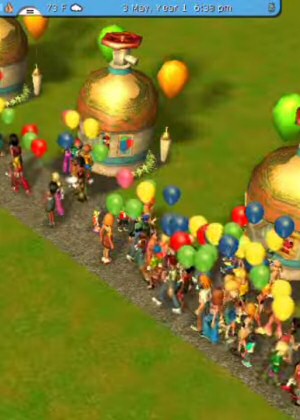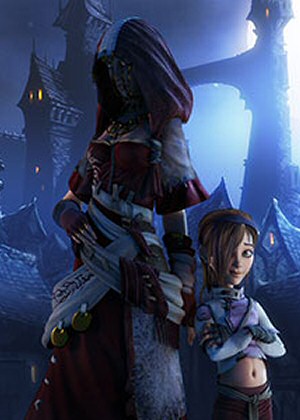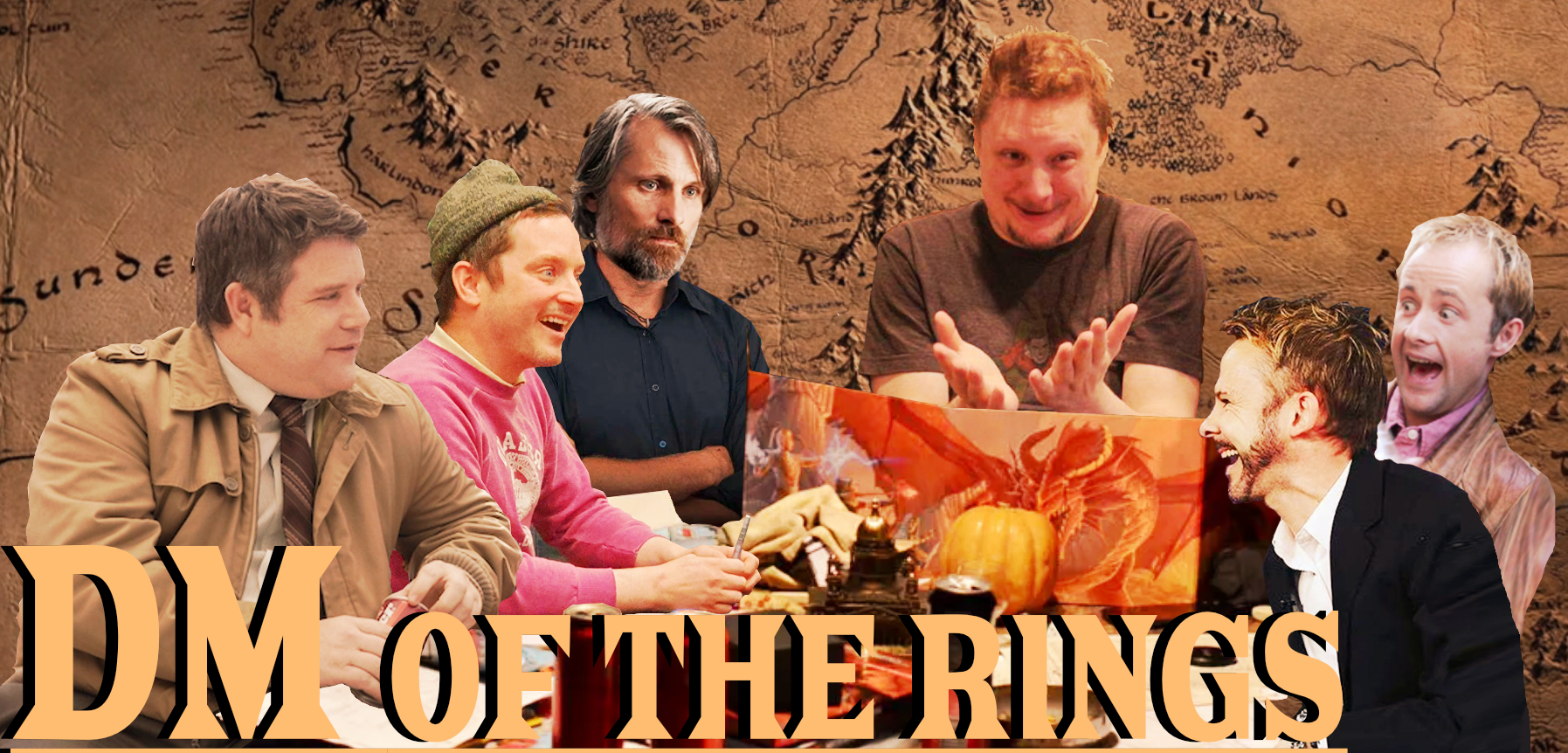
I apologize for how long it’s been since I slapped commentary down here. Right now a lot of the things I think about when I read these is ‘man, I miss my dad’. Which makes for pretty bad conversation. I’ll get back in the grooze at some point, but for now I reserve my right to sulk.
I do appreciate Legolas’s player here, though. I too enjoy being told how cool my character looked killing something.
Bowlercoaster

Two minutes of fun at the expense of a badly-run theme park.
The Opportunity Crunch

No, brutal, soul-sucking, marriage-destroying crunch mode in game development isn't a privilege or an opportunity. It's idiocy.
Bad and Wrong Music Lessons

A music lesson for people who know nothing about music, from someone who barely knows anything about music.
Pixel City Dev Blog
An attempt to make a good looking cityscape with nothing but simple tricks and a few rectangles of light.
Fable II

The plot of this game isn't just dumb, it's actively hostile to the player. This game hates you and thinks you are stupid.
 T w e n t y S i d e d
T w e n t y S i d e d

I’ve probably posted this rant before, but:
One the one hand, yeah cool descriptions are cool. The problem that drives me up the wall is that the oh so cool descriptions most people want are usually neither appropriate for the power level of the characters nor do they make any sense within the rules. Rather than understand the hit point system and give appropriate description, people just default to over the top dismemberment/etc, even when their attacks are not and could not possibly be lethal. I particularly hate when I hear the phrase “describe your kill.” I don’t want to sit here and listen to someone who understands the system even less than you, DM, make up some ridiculous over the top thing that blatantly violates fifty rules and has actual mechanical effects.
Because the not-actually-a-secret is that DnD 3.x tells you very clearly what sort of hits are happening in combat. Every hit must draw blood, as evidenced by the injury poison system. And absolutely no hits can cause a wound that would bleed out or even maim significantly enough to cause a mechanical penalty (aside from hp loss), until the target drops below 0, and even then no hit can be described in any way that could be construed as instantly lethal unless the target drops immediately to -10 or less. And that’s it, it’s that simple. Doesn’t matter if it’s a crit, or a sneak attack, or even a magic weapon that says it causes massive blood loss, if it doesn’t have the mechanics it doesn’t matter. Normal 3.x combat is a battle of attrition where you keep landing small superficial wounds that tire out your opponent until you capitalize on/they make a fatal mistake and you finally land a hit that causes them to both immediately pass out from shock/blood loss/concussion and bleed out in a minute or less, if they don’t die instantly.
And even if they die instantly, unless you have a special mechanic that lets you sever body parts, that doesn’t happen. And describing things that way, particularly giving the player carte blanche to make things up, is a problem, because there are in fact monsters that can say regenerate if their head is not cut off so they are not in fact dead and beheading them requires a deliberate extra choice and action which you just either gave away for free or revealed the significance of by needing to backtrack, or necromancers that can animate things which may have been expected by the module or even another player in the party which your bogus description has now mechanically prevented (that last one actually happened to me, I specifically took the party on a wyvern hunt so I could reanimate it, and the DM said “describe your kill” and naturally the player immediately goes into some ridiculous Skrym beheading sequence).
Like, combat should already be interesting enough. It’s a turn based tactical wargame, that’s the point. There are other games with less rigid rules where indeed this sort of description may be part of the mechanics. Sigh.
Today’s comic does avoid the pitfall of the player-based “describe your kill,” by instead having the DM be the problem themselves. Honestly not sure I’d put up with it from the DM directly either.
There’s a nice quote in introduction to the 5E DMG: “The D&D rules help you and the other players have a good time, but the rules aren’t in charge.”
Even within the mechanics of the rules, you could argue that hitpoints represent a creature’s ability to keep fighting as much as its actual bodily health — that one final 1hp hit that takes it down might simply be interpreted as the moment they finally fail to defend themselves against the over-the-top-dismembering-strike that the player goes on to describe…
This sounds weirdly venomous towards what’s essentially a flavor mechanic.
Like, I get your frustration if the DM or player’s descriptions are over the top anime nonsense every time, but on the other end of that scale, there’s very little that’s more boring in a tabletop game than hearing “You inflict N hitpoints to the enemy. He dies.” a dozen times.
KInd of agree with Oliver Faure here – it seems weirdly angry for what is usually just flavour. But then again, I haven’t really seen it used much in games I’ve been playing.
Not that I’m a massive fan of this kind of ‘describe your kill’ system. I’ve been listening to a lot of Critical Role recently, which has popularised this kind of thing with the phrase ‘how do you want to do this?’ – and the gratuitous, sadistic finshers that the cast sometimes come up with make me wonder how their characters can look each other in the eye.
Really puts the ‘murder’ in in ‘murderhobo’.
Still, I know that as a DM if one of my players tried to use a ‘describe your kill’ to acheive something mechanically ‘extra’ as the description of their kill, I’d immediately respond with ‘you try to do that, but…’ or work around it.
The Wyvern’s neck is too thick for you. Or, so you beheaded that Wyvern? The necromancer sewed it’s head back on before raising it! Or better yet, something else’s head onto the stump, making it more powerful….
I’m definitely not too keen on the describe your kills thing myself, either – it makes sense for the BBEG or some other major opponent, if you want their death to be grand and dramatic, and you can have a player narrate the final moments of some dramatic duel. My issue is when it gets overused, against Generic Troll Boss or Generic Big Animal, or even worse, when I got a “describe your kill” against some random encounter in a cave.
It rapidly diminishes the special feeling that comes from those moments, and I kind of empathize with the people who give over the top descriptions because really, there’s only so many ways you can say “I stab them real good and they fall over” before you start to worry that you’re the one who’s being uncreative and wasting peoples’ time.
Honestly it’s one of the many, many things that work excellently when used sparingly, but are incredibly easy to overuse, and a lot of DMs in my experience default to overusing such elements.
Indeed, and being that it’s a rant I’m pretty sure I’ve posted before I probably would have just taken it back down later if I’d had the option just for the unseemliness. I’m not surprised it’s popular on the big well-known DnD series, since that’s where I’ve also seen most of it, on LRR streams (where, and I’ve said this before too, it bugs me how they follow more rules in the rules-light systems than they do in the rules-heavy system: why are you playing DnD, it doesn’t fit your style and you’ve all literally admitted and know it! -because official DnD setting book).
And as you say, if the DM tries to limit the “system” of turning descriptions over to the players, they then have to backwalk it, and suddenly what should have been a few words turns into a negotiation. So much easier to just not.
As for “you deal X hp, it dies,” that’s just the other extreme. There is plenty of room in the middle for the DM to give varying descriptions to keep the energy up without going full anime nonsense or pausing the game to have a player do so (although I did have my own amusing slips, landing on a good line and then repeating it in different situations making it unclear what exactly what happening-AC, DR, everything is now “it blocks with its chest!”) Clearly I find it even more boring waiting for someone to figure out how to “describe their kill” and then possibly end up in a back and forth with the DM over it than I would find “you deal damage and it dies,” in particular because the latter means we get closer to my turn. Meanwhile the players most likely to go overboard are also the players who already take the longest on their turn, because they don’t grasp the mechanics and aren’t paying attention when it’s not their turn.
And yes, that leads quickly towards a derivative and unfair “gamers vs dirty roleplayers” thing, but, well, in my experience it can be pretty accurate. Last time I tried to implement turn timers to reign in the problem I caved to the immediate strains of protest, but next time. . .
> Every hit must draw blood, as evidenced by the injury poison system.
Not exactly. A character fighting with a poisoned blade will actively try to draw blood, while other characters might not particularly care about drawing blood as long as they tire down their opponent.
So every hit with the adequate fighting style will draw blood, but there is still room for describing hits that don’t draw blood if the attacker is not trying for to do so.
I’m leery of reading that level of agency into it- if you can simply try to draw blood and succeed, why wouldn’t you always do that? It’s literally the whole point of edged and pointed weapons. And blunt weapons will absolutely tear skin, even boxers get their faces ripped open all the time. So I’ll stick with every hit draws some blood as the default, even if I might reserve room for blunt armor crushing if there’s no poison involved.
I think it largely gets into the fuzziness of HP representing some combinations of stamina and luck for near misses versus HP as ‘meat points’ – there’s evidence for both interpretations, but also neither one of them maps fully into how the rules treat them, and the more you pick it apart the more the whole system falls apart logically.
Each hit drawing blood or doing some real damage is probably better supported by the text, but HP especially is one of the things best not interrogated to closely.
> why wouldn’t you always do that?
For variety of the narration? If there is no difference in term of mechanical effect, there is no reason to restrict yourself by absolutely forbidding the narration (from player or GMs) to have a hit that doesn’t draw blood.
And if you really want an actual application, I’d say that when you’re deliberately fighting with non-lethal damage, you’re probably also trying to avoid drawing blood from your opponent.
This is my favorite strip from the series. It resonates with me in a number of ways.
Many years ago I GM’d a Star Wars RPG with a couple of Jedi Adepts in the party. We played so much that at a certain point the Jedi became extremely overpowered. Squads of enemies were no match for them. And this strip mirrors how they acted. ” I kill the Stormtroopers” as they hold a dozen dice in their palm…
I also find that this comic gets at one of the ironies of RPGs in that we all crave combat, but we can very quickly grow bored of it, ready to move on to the next narrative on the story.
I really enjoy rereading this remastered comic and I commend you all for keeping this up!
Thank you,
Coach
I’m somewhere in between. My current DM has a good balance: his descriptions are usually in line with how important the enemy is: we get to say how we kill bosses and named characters. Other things are narrated in line with how well it went. A simple kill gets a simple ‘you kill it’, a crit gets something more special etc.
Grief can be overwhelming, and it’s okay to take the time you need to process and heal. Your readers will be here when you’re ready to come back. And I agree, it’s always nice to receive compliments about your character in a game time calculator
Seems like next week page is missing.
Did something happened?